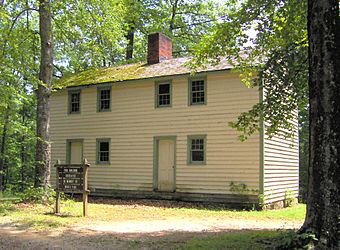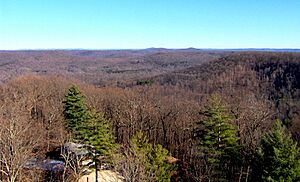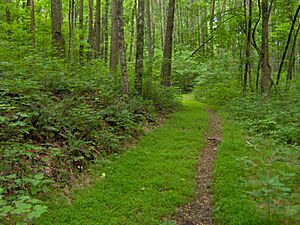Standing Stone State Park facts for kids
Quick facts for kids Standing Stone State Park |
|
|---|---|

Standing Stone Lake
|
|
| Type | Tennessee State Park |
| Location | Overton County, Tennessee |
| Area | 855 acres (346 ha) |
| Created | 1939; 1955 |
| Operated by | Tennessee Department of Environment and Conservation |
|
Standing Stone Rustic Park Historic District
|
|

Home of prominent early Overton County pioneer Moses Fiske (1754-1843), near the park entrance
|
|
| Nearest city | Livingston, Tennessee |
| Built | 1880s-1949 |
| NRHP reference No. | 86002794 |
| Added to NRHP | 1986 |
Standing Stone State Park is a fun state park in Overton County, Tennessee, in the southeastern United States. It covers about 855 acres (3.46 km2) along the shores of Standing Stone Lake, which is a man-made lake covering 69-acre (0.28 km2). The park is surrounded by the much larger 11,000-acre (45 km2) Standing Stone State Forest.
Both the park and forest were created in the 1930s. This was part of a big government plan called the New Deal. The goal was to help farmers who were struggling and to fix land that had been damaged. The park got its name from a mysterious rock called the Standing Stone. People believe it was important to Native Americans and once stood near Monterey. Today, the park is a great place for canoeing, camping, hiking, and many other outdoor activities.
Contents
Where is Standing Stone State Park?
Standing Stone State Park is located on the eastern part of the Highland Rim. This is a high, flat area that surrounds the Nashville Basin. The park sits between this rim and the higher Cumberland Plateau to the east. Just a few miles north, you'll find Dale Hollow Lake, which is a large body of water formed by the Obey River.
Mill Creek is the main stream in the park. It flows from Reynolds Mountain in the east, winding through the hills. It eventually joins the Cumberland River. Inside the park, Mill Creek makes a horseshoe shape around a steep ridge. Two smaller streams, Morgan Creek and Bryans Fork, join Mill Creek here. This creates an interesting X-shaped lake called Standing Stone Lake. Tall hills like Cooper Mountain and Goodpasture Mountain rise up around the lake.
You can reach the park by driving on Tennessee State Route 136. This road connects to other main roads like Tennessee State Route 85 and Tennessee State Route 52. The town of Livingston is also nearby.
Standing Stone State Forest: A Natural Neighbor
Standing Stone State Park is completely surrounded by Standing Stone State Forest. This forest is managed by the Tennessee Division of Forestry. Unlike the state park, the forest doesn't have special places for recreation like campgrounds. However, people are allowed to visit and explore it. Signs, blazes, or ribbons clearly mark the line between the park and the forest.
When the United States Department of Agriculture bought this land in the 1930s, the forest was in bad shape. It had been damaged by fires, too much logging, and poor farming methods. Standing Stone became a state forest in 1961. Most of the trees in the forest are hardwoods, like oak and maple. Many of these trees are quite old, with some being over 80 years old.
A Look Back in Time
Long ago, Native Americans lived in this area. They had villages and used rock shelters in Northern Overton County. Legends say that the Overton area was a place often fought over by different tribes. These included the Shawnee and the Cherokee. By the mid-1700s, the Cherokee were in control of the area. A Cherokee chief named Nettle Carrier had a camp near the park.
Long hunters were some of the first European-Americans to explore this part of Tennessee. They came here in the 1760s, following the Cumberland River. Famous explorers like Daniel Boone are thought to have camped near Mill Creek around 1763.
The park's name comes from a mysterious stone that early pioneers found. It was special to Native Americans. William Walton found the stone in the late 1780s near what is now Monterey, about 20 miles (32 km) southeast of the park. The stone was about 10 feet (3.0 m) tall and looked like a dog sitting up. No one knows for sure why it was there. Some people think it marked the border between different Native American tribes. Others believe it was a guidepost for hunting parties. The stone was a well-known landmark for travelers in the early 1800s. Sadly, the Standing Stone was blown up in 1893 to build a railroad. However, some pieces were saved and one is now part of a monument in Monterey City Park.
How the Park Was Built
Standing Stone State Park was part of the New Deal programs, like the Works Progress Administration and the Resettlement Administration. These programs helped poor farmers and worked to fix damaged land. Work on the park began in 1935. It had three main goals: to help farmers in the Mill Creek area move, to restore the forest and stop soil erosion, and to create fun places for people to visit. The Civilian Conservation Corps (CCC), a group of young men who worked on conservation projects, also helped build the park. The land was then leased to the Tennessee Division of State Parks in 1939.
During World War II, work on the park mostly stopped. Many of the buildings and facilities started to fall apart. After the war, everything was fixed up. The cabins were renovated, the lake was drained and refilled with fish, and a leak in the dam was repaired. The United States government officially gave the land to the State of Tennessee in 1955.
Fun Things to Do at the Park
Standing Stone State Park has lots of great facilities for visitors. There's a campground with 36 sites for tents or RVs. You can also stay in one of the 21 cabins, which range from simple to modern. There are four group lodges for larger gatherings. The park also has an Olympic-size swimming pool, many picnic areas, and an amphitheater for shows. Most of these are located on a ridge overlooking the lake.
There are over 8 miles (13 km) of hiking trails in the park and forest. A popular trail is the Lake Trail, which goes down to Standing Stone Dam and follows the lake shore. For a longer adventure, try the 8-mile (13 km) Cooper Mountain Loop Trail. This trail goes through the state forest before coming back into the park.
A special event held every September at Standing Stone State Park is the National Rolley Hole Marbles Championship. Rolley hole is a unique type of marbles game popular in the Tennessee-Kentucky area. Other yearly events include the Spring Naturalist Rally in April and the Standing Stone Car Show in October.
Images for kids










